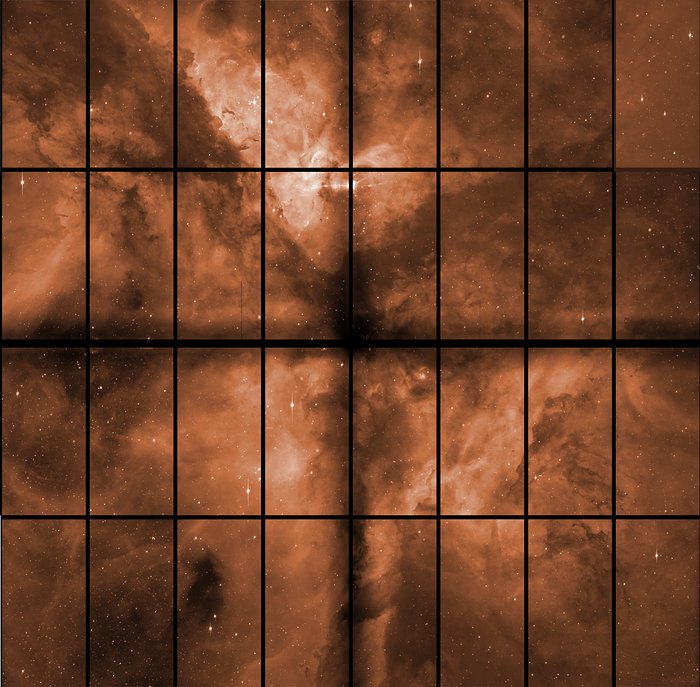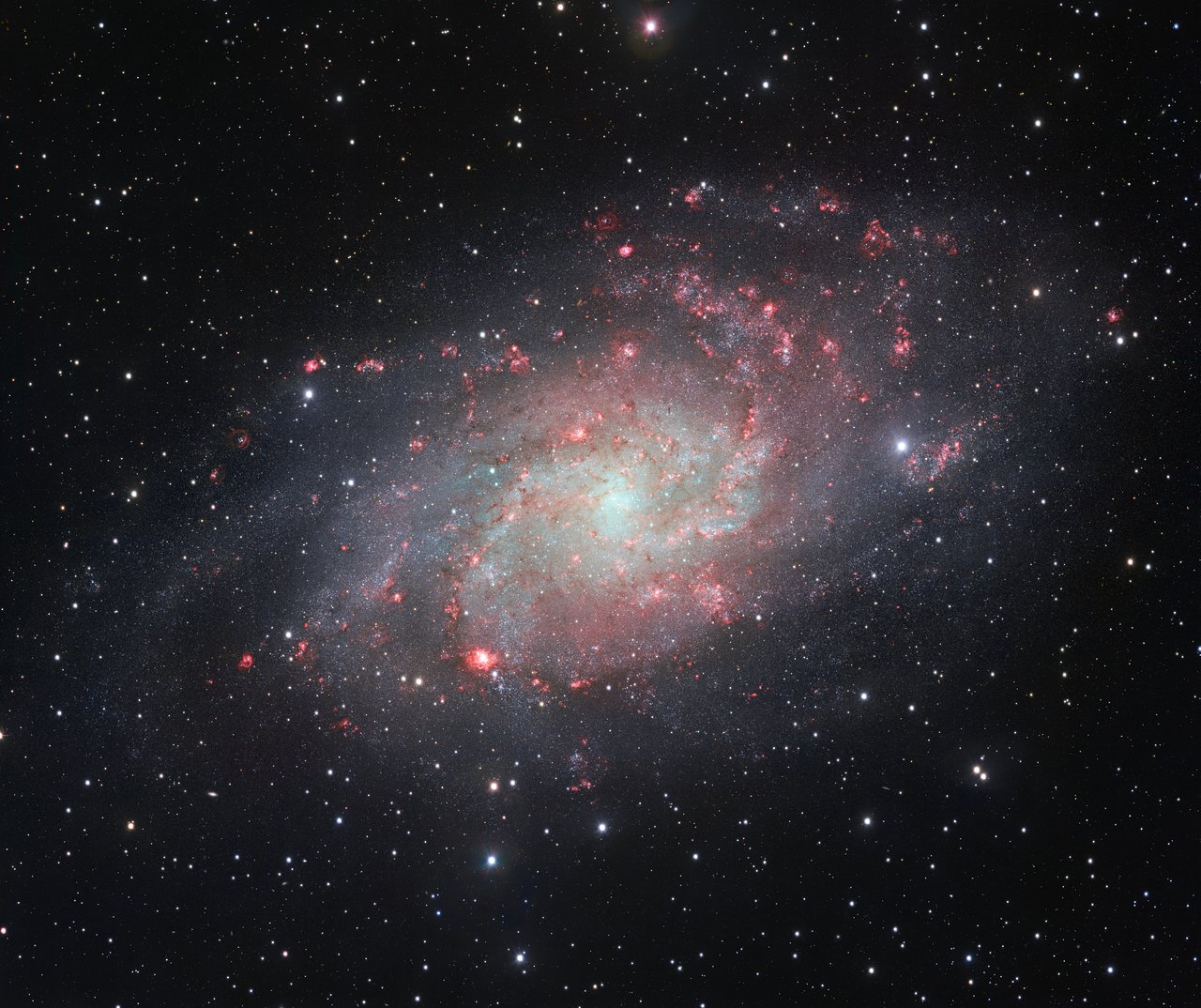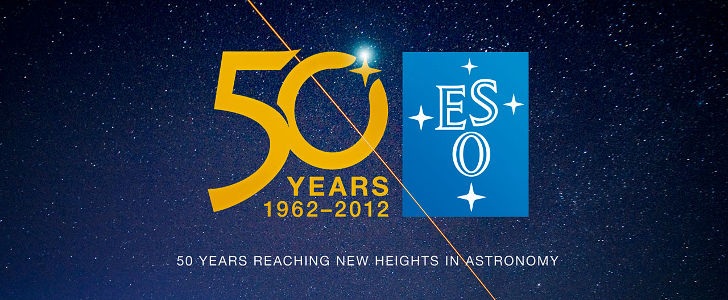From ESOblog (EU)
at
European Southern Observatory [Observatoire européen austral][Europäische Südsternwarte] (EU) (CL)
Ten years of the VLT Survey Telescope
Next week, the VLT Survey Telescope (VST) [below], located at ESO’s Paranal Observatory in the Chilean Atacama Desert, celebrates its tenth birthday. The anniversary marks ten years since the telescope’s “first light”, when it opened its eye to the sky and collected light for the first time. However, the story of the VST begins long before this point and proves to be an ultimate tale of triumph in the face of disaster… To find out more, we spoke to Massimo Capaccioli, principal investigator of the VST; Pietro Schipani, project manager during the telescope’s commissioning; Konrad Kuijken, principal investigator of the VST’s OmegaCAM instrument; and Enrichetta Iodice, principal investigator of one of VST’s science programmes.
The skyline of Cerro Paranal is dominated by the four 8.2-metre telescopes that are part of ESO’s Very Large Telescope [below]. But these cyclopes share the mountain summit with smaller telescopes, including a 2.6-metre one: the VLT Survey Telescope (VST). Although VST takes its name from its larger neighbours, it serves a completely different purpose. Rather than scrutinising small patches of the sky in great detail, the VST constantly scans much wider areas of the sky, mapping and cataloging celestial sources, following the evolution of objects that change in time, and discovering the rare and unknown.

All four of the VLT’s Unit Telescopes can be seen in this image, as well as the VLT Survey Telescope (far right). Whereas the VLT is designed to examine small areas of the sky in tremendous detail, the VST surveys large swathes of the sky in a much shorter period of time, collecting a huge archive of data that can be used to find small, interesting objects, such as near-Earth asteroids, exoplanets, and distant quasars.
Credit: A. Tudorica/ESO.


The first released VST image shows the spectacular star-forming region Messier 17, also known as the Omega Nebula or the Swan Nebula, as it has never been seen before. This vast region of gas, dust and hot young stars lies in the heart of the Milky Way in the constellation of Sagittarius (The Archer). The VST field of view is so large that the entire nebula, including its fainter outer parts, is captured — and retains its superb sharpness across the entire image. The data were processed using the Astro-WISE software system developed by E.A. Valentijn and collaborators at University of Groningen [Rijksuniversiteit Groningen] (NL) and elsewhere.
Credit: ESO/INAF-VST/OmegaCAM. Acknowledgement: OmegaCen/Astro-WISE/Kapteyn Astronomical Institute University of Groningen [Rijksuniversiteit Groningen] (NL).
“If you would like to have an idea of how things work in the Universe, you need to view a large number of objects or structures.”
“To do this, you need dedicated instruments, with as wide a field of view as possible,” says Massimo Capaccioli, from the Italian National Institute for Astrophysics (INAF Italian National Institute for Astrophysics [Istituto Nazionale di Astrofisica] (IT)). The VST hosts only one instrument, OmegaCAM, an optical camera with a field of view so large you could fit four images of the full Moon in it.

OmegaCAM detects the light captured by the VST, with such good image quality that it delivers crisp images with small, round stars from corner to corner.
Astronomers find it useful to survey the skies because they can’t directly experiment with the objects they study, so they circumvent this by observing lots of them.
Per aspera ad astra: through hardships to the stars
The idea for the VST first came about in the 1990s, at the Astronomical Observatory of Capodimonte [Osservatorio Astronomico di Capodimonte] (IT) in Italy (now a part of INAF), which Capaccioli directed back then.
“It looked like a crazy idea that a small institute like Capodimonte was proposing a telescope for the best observatory in the world!” says Pietro Schipani (INAF). “But you have to be brave sometimes”.
The light-polluted Italian skies led the Capodimonte astronomers to seek a partnership with ESO, allowing the telescope to be built at ESO’s Paranal Observatory, which boasts some of the darkest and clearest skies on the planet. In 1998, a memorandum was signed between Massimo Capaccioli and the director general of ESO, giving the go-ahead for the project to begin.
OmegaCAM was designed and built by a consortium from the Netherlands, Germany and Italy, and ESO manufactured the 268-megapixels array of detectors. The project was led by Konrad Kuijken, from Leiden University [Universiteit Leiden] (NL); an astronomer by trade, whose scientific interest –– measuring how dark matter bends light and distorts the shapes of galaxies –– inspired him to take on the project.

Image of the OmegaCAM under construction, the camera for the VLT Survey Telescope (VST) in the Chilean desert. The OmegaCAM will provide views of faint and rare objects for the Very Large Telescope to then examine, and work as a surveyor for trans-Neptunian objects, distant galaxy clusters, and other astronomical objects. It succeeds the present Wide Field Imager (WFI) at the 2.2-m MPG/ESO Telescope on La Silla [below]. Credit: ESO.


This raw image, straight from the OmegaCam instrument on the VST, was used together with many others to produce the iconic photo of the Carina Nebula (eso1250). The images taken with astronomical instruments are always in intensity scale: the colour information is obtained by taking exposures through different glass filters. The 32 individual 8-megapixel detectors are visible, separated by black gaps. In the final image, these are filled by combining images taken at slightly different positions. Long “bleeds”,caused by bright stars saturating the detector, are also visible.
Credit: ESO.
Work on the telescope progressed well until 2002, when disaster struck during the transport of the VST primary mirror to Chile. Capaccioli remembers this incident with despair: “Unfortunately, an accident involving the cargo during an intermediate stop over in Central America caused destruction of the beautiful primary mirror. It was literally reduced to crumbs, the largest astronomical mirror ever destroyed.”
The whole project ground to a halt. The VST was built around its primary mirror and work was not able to continue until it was recast, causing a four-year delay and seriously damaging the morale of the team, leading to many engineers leaving the project.
But the VST’s misfortune didn’t end there. “In terms of shipping, this project was clearly cursed!” says Kuijken.
In 2009, the support system for the primary mirror was shipped to Chile. Alas, during transport seawater seeped into the box containing the mirror support, damaging it beyond repair. Schipani remembers opening the box and discovering the flood. “There were silica gel bags to prevent humidity… and they were floating in the water.” No one could have foreseen quite how humid the conditions in the box were going to end up!
After another year’s delay, every part of the telescope finally reached Paranal. It was now ready for commissioning, the stage where astronomers and engineers work side-by-side, fine-tuning the telescope and camera to ensure they perform as expected.
In particular, delivering perfectly crisp images was key. As Schipani says: “Sometimes I summarise my work by saying that I try to make the stars round and small. In Paranal the atmospheric conditions are fantastic, so all the defects of the machine that you are building will be perfectly seen on the image. So you must really take care of all the details.”
Finally, the VST was ready for first light. This moment was eagerly awaited by Capaccioli, who recalls asking the team at Paranal to “call at any time, day or night, when the photons go through and produce something.” Kuijken adds, “It was one of the most exciting times in my career, for sure.”
First light at last
In spite of all the setbacks, the VST had done it, and the first images proved it was working beautifully. Although the construction process was fraught with difficulties, the scientists and engineers working on the project found that there had been some silver linings to the long wait for the VST.
“We have learned that if you have to redo something, it often turns into an opportunity to improve it,” says Capaccioli. “If you have a second chance, the prototype will be better. Usually with telescopes, you make it once and then you don’t repeat it. In the case of the VST disasters, we used this as an opportunity.”
Scientists and engineers often approach these complex problems from opposing points of view. “Sometimes the best solution engineering wise is not the best solution science wise,” says Kuijken. “To resolve this you have to understand a little bit from both sides of the argument.” Teamwork was thus key to the project reaching its completion.

The second released VST image, showing the Omega Centauri globular cluster, an agglomeration of hundreds of thousands stars. The sharp stars in this view demonstrate the superb image quality of the telescope and its camera. Credit: ESO/INAF-VST/OmegaCAM. Acknowledgement: A. Grado, L. Limatola/INAF-Capodimonte Observatory.
While working round the clock in such a remote location is certainly challenging, the magical atmosphere of Paranal left the team with some unforgettable memories. “Walking around between these telescopes on a beautiful starry night, it’s like being in a temple,” Kuijken says. This silence was often broken by the excitement of the astronomers, as Schipani remembers: “Paranal is a quiet place but during the nights you could hear on the platform people screaming and crying ‘Oh, fantastic!’ as they made observations.”
Iodice concurs: “There in Paranal it is like a big family,” she says. “You can interact with the engineers, astronomers and telescope operators all at the same levels, and each of us there has a particular knowledge and experience. Sharing this is fantastic. I always enjoyed the environment and the atmosphere. I feel I work better there.”
Now in its tenth year, has the VST achieved the goals set out so long ago at the start of its journey? Iodice, who is the principal investigator of the VST Early-type GAlaxy Survey, certainly thinks so. The survey she leads initially concentrated on the brightest galaxies in the nearby Universe, but has more recently switched focus to fainter structures, such as ultra-diffuse galaxies — objects as large as the Milky Way but hundreds of times fainter, whose origin is still unknown. “We detected these ultra-diffuse galaxies by chance in our VST surveys. The results we achieved with the VST exceeded our expectations,” she says.

The wide-field optical camera on ESO’s VLT Survey Telescope (VST) — has captured the spectacular Orion Nebula and its associated cluster of young stars in great detail, producing this beautiful new image. This famous object, the birthplace of many massive stars, is one of the closest stellar nurseries, at a distance of about 1350 light-years. Credit: G. Beccari/ESO.

The VLT Survey Telescope (VST) at ESO’s Paranal Observatory in Chile has captured this beautifully detailed image of the galaxy Messier 33, often called the Triangulum Galaxy. This nearby spiral, the second closest large galaxy to our own galaxy, the Milky Way, is packed with bright star clusters, and clouds of gas and dust. This picture is amongst the most detailed wide-field views of this object ever taken and shows the many glowing red gas clouds in the spiral arms with particular clarity. Credit: ESO.
The VST has helped to unravel mysteries in other corners of the Universe: it has imaged stellar nurseries in our own galaxy, mapped the distribution of dark matter in the Universe –– what first drove Kuijken into leading OmegaCAM –– and even captured the violent collision of two neutron stars. As one of the best optical survey telescopes operating in the Southern Hemisphere, the VST continues to deliver stunning images of the Universe.
The VST holds a special place in the hearts of all who worked on it, and refused to give up on it when the going got tough. “I am happy and proud of the VST as a father would be of a very successful son who has had a difficult childhood,” says Capaccioli. Schipani adds, “I have worked on the VST for a period of about ten years. It’s not like a normal project, it is really a part of me.”
See the full article here .

five-ways-keep-your-child-safe-school-shootings
Please help promote STEM in your local schools.
![]()
Stem Education Coalition
Visit ESO (EU) in Social Media-
![]()
European Southern Observatory [Observatoire européen austral][Europäische Südsternwarte] (EU) is the foremost intergovernmental astronomy organisation in Europe and the world’s most productive ground-based astronomical observatory by far. It is supported by 16 countries: Austria, Belgium, Brazil, the Czech Republic, Denmark, France, Finland, Germany, Italy, the Netherlands, Poland, Portugal, Spain, Sweden, Switzerland and the United Kingdom, along with the host state of Chile. ESO carries out an ambitious programme focused on the design, construction and operation of powerful ground-based observing facilities enabling astronomers to make important scientific discoveries. ESO also plays a leading role in promoting and organising cooperation in astronomical research. ESO operates three unique world-class observing sites in Chile: La Silla, Paranal and Chajnantor. At Paranal, ESO operates the Very Large Telescope, the world’s most advanced visible-light astronomical observatory and two survey telescopes. VISTA works in the infrared and is the world’s largest survey telescope and the VLT Survey Telescope is the largest telescope designed to exclusively survey the skies in visible light. ESO is a major partner in ALMA, the largest astronomical project in existence. And on Cerro Armazones, close to Paranal, ESO is building the 39-metre European Extremely Large Telescope, the E-ELT, which will become “the world’s biggest eye on the sky”.
European Southern Observatory [Observatoire européen austral][Europäische Südsternwarte] (EU) is the foremost intergovernmental astronomy organisation in Europe and the world’s most productive ground-based astronomical observatory by far. It is supported by 16 countries: Austria, Belgium, Brazil, the Czech Republic, Denmark, France, Finland, Germany, Italy, the Netherlands, Poland, Portugal, Spain, Sweden, Switzerland and the United Kingdom, along with the host state of Chile. ESO carries out an ambitious programme focused on the design,


 MPG Institute for Astronomy [Max-Planck-Institut für Astronomie](DE) 2.2 meter telescope at/European Southern Observatory(EU) Cerro La Silla, Chile, 600 km north of Santiago de Chile at an altitude of 2400 metres.
MPG Institute for Astronomy [Max-Planck-Institut für Astronomie](DE) 2.2 meter telescope at/European Southern Observatory(EU) Cerro La Silla, Chile, 600 km north of Santiago de Chile at an altitude of 2400 metres.
 European Southern Observatory(EU)La Silla Observatory 600 km north of Santiago de Chile at an altitude of 2400 metres.
European Southern Observatory(EU)La Silla Observatory 600 km north of Santiago de Chile at an altitude of 2400 metres.
 European Southern Observatory(EU) , Very Large Telescope at Cerro Paranal in the Atacama Desert •ANTU (UT1; The Sun ) •KUEYEN (UT2; The Moon ) •MELIPAL (UT3; The Southern Cross ), and •YEPUN (UT4; Venus – as evening star). Elevation 2,635 m (8,645 ft) from above Credit J.L. Dauvergne & G. Hüdepohl atacama photo. [/caption]
European Southern Observatory(EU) , Very Large Telescope at Cerro Paranal in the Atacama Desert •ANTU (UT1; The Sun ) •KUEYEN (UT2; The Moon ) •MELIPAL (UT3; The Southern Cross ), and •YEPUN (UT4; Venus – as evening star). Elevation 2,635 m (8,645 ft) from above Credit J.L. Dauvergne & G. Hüdepohl atacama photo. [/caption]

•KUEYEN (UT2; The Moon ),
•MELIPAL (UT3; The Southern Cross ), and
•YEPUN (UT4; Venus – as evening
 ESO Very Large Telescope 4 lasers on Yepun (CL)
ESO Very Large Telescope 4 lasers on Yepun (CL)





 European Southern Observatory(EU)/MPG Institute for Radio Astronomy [MPG Institut für Radioastronomie](DE) ESO’s Atacama Pathfinder Experiment(CL) high on the Chajnantor plateau in Chile’s Atacama region, at an altitude of over 4,800 m (15,700 ft).
European Southern Observatory(EU)/MPG Institute for Radio Astronomy [MPG Institut für Radioastronomie](DE) ESO’s Atacama Pathfinder Experiment(CL) high on the Chajnantor plateau in Chile’s Atacama region, at an altitude of over 4,800 m (15,700 ft).

 ESO Next Generation Transit Survey telescopes, an array of twelve robotic 20-centimetre telescopes at Cerro Paranal,(CL) 2,635 metres (8,645 ft) above sea level.
ESO Next Generation Transit Survey telescopes, an array of twelve robotic 20-centimetre telescopes at Cerro Paranal,(CL) 2,635 metres (8,645 ft) above sea level.

 European Southern Observatory(EU) ExTrA telescopes at erro LaSilla at an altitude of 2400 metres.
European Southern Observatory(EU) ExTrA telescopes at erro LaSilla at an altitude of 2400 metres.




